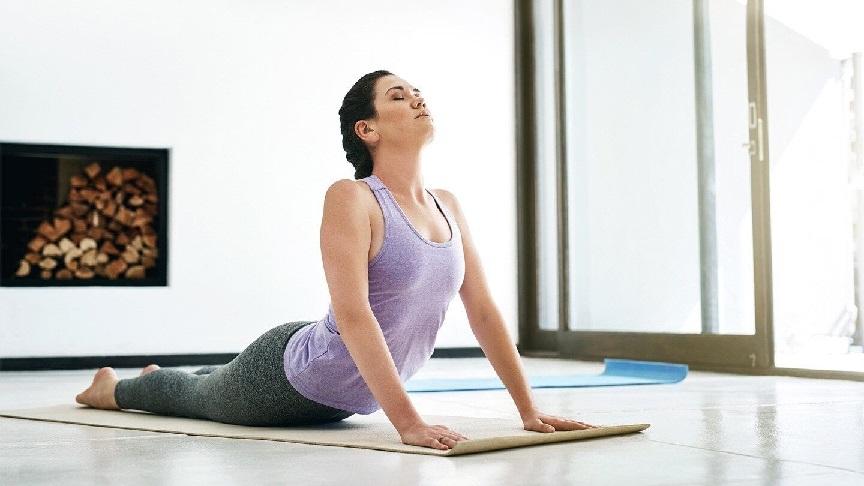Yoga can provide a range of benefits for the body, from mental well-being to building better core strength. Practicing yoga can also be extremely effective at relieving back pain, targeting the spine to make the back muscles stronger and more flexible.
In this article, we will consider the benefits of yoga for lower back pain relief. Outlining how people suffering from lumbar spinal stenosis, a herniated disc, or other back problems can manage their pain and aid recovery.

What is Yoga?
Yoga is a type of exercise that involves a series of practices that are based on physical, mental, and spiritual aspects of the body. Targeting both the mind and body, yoga is a combination of focusing the mind while performing muscular movements. This is achieved in various ways such as controlled breathing and channeling energy.
The origins of yoga can be traced back over 5,000 years to the Indus-Sarasvati civilization in India. It was created as a spiritual practice and the earliest written records of the exercise can be found in text that is dated around 1500 BCE.
For managing back pain, Hatha yoga is most commonly practiced. This type of yoga involves many different postures (asanas) that are performed in sequence, helping to align the muscles, bones, and even skin. It works by opening the body’s channels, especially the spine to promote better energy and blood flow.
What are the Main Benefits of Yoga for Back Pain?
Yoga can be extremely beneficial for anyone suffering from persistent back pain that returns sporadically. In this section, we will outline 5 of the main benefits of yoga for relieving back pain, ranging from muscle relaxation to better mental health.
- Relaxes and Stretches the Muscles
Yoga postures are held for between 10 to 60 seconds, helping to relax and stretch the muscles. This relieves any tension in the muscles to improve the flexibility of not only the muscles but also the joints and ligaments in the spine. By flexing the muscles, yoga promotes relaxation and leaves the body feeling refreshed and limber.
- Improves Blood Flow
Yoga involves breathing techniques, with a focus on long and rhythmic breathing, inhaling and exhaling during each pose. Focused breathing helps a person to relax which in turn, improves blood flow around the body. By improving blood flow, the tissues in the body receive more nutrients, and waste is removed, resulting in better spine health.
- Strengthens The Muscles
Yoga is great for building strength, with different postures targeting both individual muscles and groups of muscles, especially those in the back and abdomen. By performing these postures regularly, and holding them for longer periods, your body will eventually get stronger. The stronger your spine becomes, the likelihood of back pain decreases.

- Spinal Alignment
Yoga poses work on aligning the body, particularly the spine. By working towards a more naturally aligned spine your posture and balance will gradually improve. Many spinal conditions and back pain is caused by misalignment, brought on by years of bad posture. This is common in people who work at a desk for long hours. Performing yoga regularly ensures your head, shoulders, and pelvis are aligned as they should be.
- Better Mental Health
As well as relaxing the body, yoga also relaxes the mind and contributes to better mental health and well-being. Yoga works as a form of meditation in addition to being a great exercise, relieving stress and anxiety to have an immense impact on a person. Many people experience significant mood changes after performing yoga and it is recommended for anyone suffering from back pain to help alleviate any frustrations or negative thoughts that the pain is causing.
Pain perception is a link between the body and the mind, with the body sending signals of physical stress that are then processed by the brain as pain or other feelings. Research also shows that if a person is feeling depressed or frustrated then pain levels can be heightened. Therefore, attaining a relaxed and happy state of mind can reduce pain levels in the same way.
Other Treatments Yoga Can Be Combined With
Yoga can be an effective pain management tool. However, for chronic back pain, it is advised to consult with a doctor who can recommend additional treatments to relieve any symptoms.
Other back pain treatments that may be recommended by a medical professional include:
- Painkillers, anti-inflammatories, and muscle relaxants
- Physical therapy
- Gentle exercises such as walking or swimming regularly
- Massage therapy
- Hydrotherapy
- Painkilling injections
- A back brace
- Acupuncture
- Dietary changes
- Lifestyle adjustments such as avoiding heavy lifting or maintaining better posture
- Heat/ Ice packs
- Electro-treatment

What If Yoga and Other Treatments Do Not Work?
If yoga and the treatments listed above fail to solve your back pain problem then your doctor may recommend surgery to provide permanent relief. The type of surgical procedure will depend on your condition. For example, a discectomy would be performed to cure a herniated disc, while a laminectomy would be the most likely option for spinal stenosis. These operations may also be combined with spinal fusion to provide stability to the affected vertebrae.
As an alternative to traditional spinal stenosis surgery like spinal fusion, a person may consider the advantages of a mechanical spinal device. These devices are growing in popularity as they avoid some of the problems that are associated with spinal fusion. These problems can include long recovery times and a lack of mobility in the spine where the bones have been fused. Furthermore, spinal fusion can also cause damage to adjacent vertebrae that were previously healthy.
Thank you for reading. We hope this article has helped to highlight the key benefits of yoga in terms of managing back pain and in terms of a person’s broader mental and physical health.
